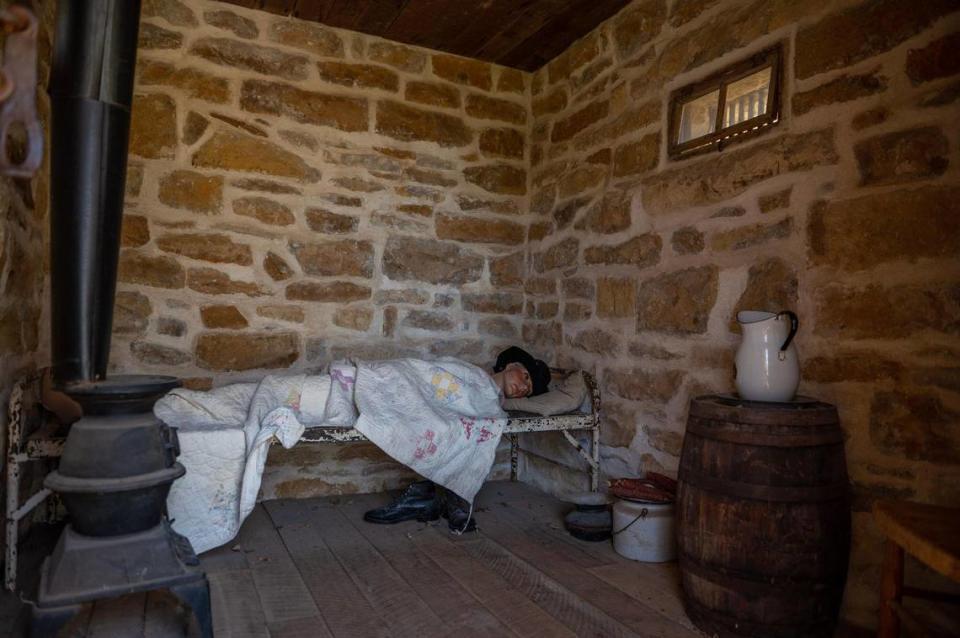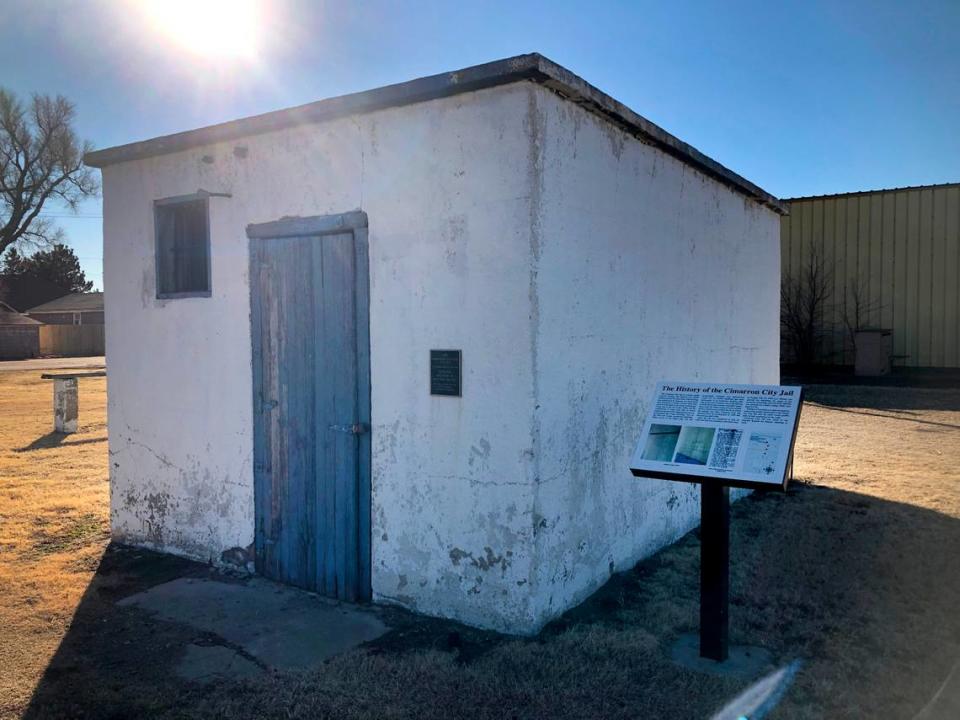‘Hiding in plain sight’: The eccentric, endangered tiny jails scattered across Kansas
About 20 years ago, Gerald Swart spotted his town jail sitting in a neighbor’s iron pile. It was just a big cage, really: a square box with iron lattice and a couple of chains hanging off a side door. A black sign with amateurish lettering said “GOFF CITY JAIL.”
“It used to be right north of the bank in Goff when I was growing up,” Swart, 82, said of the jail. “They’d lock up drunks and keep ‘em in there overnight. But that ended sometime around the ‘50s.”
Swart bought the jail from the neighbor for $11 and hauled it over to his property. It sits there to this day, not far from a building he calls Skeezix’s Toy Museum, where Swart houses his collection of vintage toy trucks, tractors and other farm implements. “I’ve tried to research its history,” Swart said of the jail, “but all the reports from those days, they’re all lost.”
Sometimes called tiny jails, sometimes called calabooses, single-cell holding structures like the Goff City Jail are scattered all across the prairie towns of Kansas. Most date back to sometime around the turn of the last century. Some, like Swart’s, look like bear cages. Others are built from native stone or poured concrete.
Inside is just enough room for a prisoner, maybe two. A relic of harsher times on the frontier, they were used most often to temporarily hold troublemakers awaiting transport to county jails or larger towns.
“They’re kind of just sitting out there hiding in plain sight,” said Emily Cowan, whose work researching tiny Kansas jails recently led the Kansas Preservation Alliance to add the structures to the state’s Most Endangered List. “Some places have chosen to repaint them or preserve them somehow, or include them as part of a historical museum. But many are deteriorating and forgotten about, and information on them is scarce.”
Cowan has so far documented about 50 tiny jails in Kansas, plus more in Missouri and Oklahoma. They are in places like Bison (population: 179) and Zenda (population: 72) and Mahaska (population: 46).
“Almost every town up here had a little place like that,” said Jo Rippe of the Washington County Historical Society. “Mahaska, Palmer, Greenleaf, Hanover. We don’t do much with them. If there’s some kind of gathering in town, maybe a few people stop and look.”
In Mound Valley, about 20 miles north of the Oklahoma border in southeast Kansas, local officials have recently been discussing how to preserve their local calaboose, built in the late 1800s, according to Kevin Keltz, board chair of the Mound Valley Historical Society.
Tucked behind what is now a convenience store called Porky’s, the 10-by-14-foot red-brick structure has an arched ceiling and a connected outhouse that was added at some point after its construction. It sits on city-owned property and is locked, the locals say, to keep people from fornicating and using drugs inside.
“It’s in really horrible shape, and we don’t want people in there messing around,” said Tammie Logan, Mound Valley city clerk.
Logan said the City Council voted in 2021 to appropriate funds for masonry work on the jail. But brick masons are hard to find in that part of the state, and the one quote they got for the work was $8,000 — a steep price for a town of 348.
“For such a tiny little building, it’s quite a bit just to make it look nice and keep the roof from falling in,” Logan said. “But we really don’t want to lose it. In 1907, we had a couple of major fires that burned a lot of the original town, so there’s not a lot of original buildings left, and this is one of them. We want it to be a safe structure where, when we have events like the Flagpole Festival in June, people can go inside it and have a look, take pictures, things like that.”

There is some precedent for such preservation efforts. Outside Lawrence in 2011, the Lecompton Historical Society received a $55,000 cultural heritage grant from the Douglas County Commission that it used to relocate Lecompton’s rapidly deteriorating 11-by-13-foot, 1892-built limestone jail off private property and onto property owned by the historical society.
The restoration provided, according to the grant application, “an educational opportunity for students and adult visitors to experience firsthand what, by today’s standards, was cruel and unusual punishment.”
“We took it apart piece by piece, with each stone numbered so it could be put in exactly the same spot,” said Dan Rockhill, a University of Kansas professor whose firm, Rockhill and Associates, oversaw the project. “The stone floor, the original wooden door, the bars across the opening, the hardware — everything like it was, just moved a few hundred feet across an alley.”
And way out in Wyatt Earp territory, five and a half hours southwest of Kansas City, the Cimarron City Jail was placed on the National Register of Historic Places in 2019. Prisoners were kept in the white concrete structure, built in 1929, until the sheriff could be located and take them to the bigger county jail, also in Cimarron.
Along with graffiti, the walls inside contain markings that indicate how long certain prisoners stayed in the cell.
The historic register states that the jail was in use only until 1958, but local resident Pete Thomas remembers things a little differently.
“My dad was sheriff in the late ‘60s, and he used it to put drunks in to sleep it off,” Thomas said. “It was right next to the swimming pool and everyone tried to look in the high window to see who was there. I recall lifting and being lifted to see inside.”

In recent years, before the National Register designation, the city had been storing various items in the 12-by-16-foot structure, said Sara McFarland, a local historian who works at the Cimarron City Library. “Now there’s nothing in there at all except the old chimney that doesn’t work and a small toilet and sink in the holding cell. But we’ve got signage outside now. People around here laugh a little about it, having this tiny old jail on the national register. But I think it’s kind of cool.”
You won’t learn it from the plaque outside, but McFarland shared a story she dug up in the local paper The Jacksonian from 1929, the year Cimarron’s calaboose was built. Three men who’d stolen a Chevrolet in Los Angeles were picked up in Cimarron after stealing a tire and rim from a local automotive company. Two were put in the county jail, the other in the city jail. Overnight, the men in the county jail escaped by busting down the door and tying several blankets together, which they hung out a third-story window and climbed down to the ground.
In the dark, they made their way over to the tiny jail, where the third member of their gang was locked up. They took $20 from the man, left him inside the cell, and disappeared into the night.
“No trace of them has been found,” the newspaper reported.
